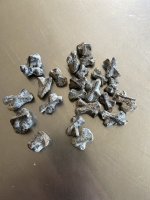cactusjumper
Gold Member
I would suggest reading a few books concerning Apache history. Grenville Goodwin would be a fine start.
There have been a few Apache-like artifacts found in and around the Superstitions. Most, if not all, are fakes by people trying to establish an Apache presence in the range. One of the better known was a ceremonial spear hidden in a crevice. I believe many of the more recent "finds" are an effort to establish the perp' as an authority on the Apache people. I suspect said perp's book has been placed on a back burner. You may need more than your imagination to re-write history.
Good luck,
Joe Ribaudo
There have been a few Apache-like artifacts found in and around the Superstitions. Most, if not all, are fakes by people trying to establish an Apache presence in the range. One of the better known was a ceremonial spear hidden in a crevice. I believe many of the more recent "finds" are an effort to establish the perp' as an authority on the Apache people. I suspect said perp's book has been placed on a back burner. You may need more than your imagination to re-write history.
Good luck,
Joe Ribaudo






